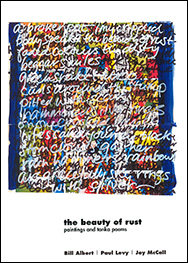


|
Paperback |
|
the beauty of rust I began writing tanka at the urging of Joy McCall, an internationally celebrated tanka poet, with whom I share, among other things, the same publisher and the same city. Many of my first poems were inspired by old family photographs. Thetanka were composed in order to remember and to celebrate. This was given added impetus by the recent death of my mother. Tanka is a form of Japanese poetry which was developed between the 12th and 13th centuries. Although originally used to express love, thanks or self-awarer:iess, now almost anything can be a subject. For example, some of the poems in this book are meditations on disability, as both Joy and I are wheelchair users. In Japanese tanka poems are composed of five lines and a syllable count of 5/7/5/7/7. However, when written in English the original metre is better captured by the count 4/5/3/5/5. The latter form has not been embraced by all Western tanka poets but is used for most of the poems in this collection. Tanka strings are more than one linked poem generally on the same theme. This echoes the original love tanka which were written as a way of two lovers communicating their feelings to one another. A tanka string can also be written by a lone poet. Tanka prose is a mixture of poetry and pros.e which is connected by the same theme. It can be written with either a prose section followed by a poem which serves as a coda or with the tanka and then the prose. Some are also done by interleaving poetry and prose. How this collection of photographs, tanka and paintings came about is the subject of Paul Levy’s introduction. Bill Albert I have been making paintings, prints and mixed media works for ten years. In that time I have often incorporated writing into my pictures. Towards the end of 2017, an idea sparked in an Artslab workshop at the Sainsbury Centre for Visual Arts sent me off in a new direction of making the text element a much larger part of the work. I was using the words of poets and writers I was reading every day at that point -Richard Brautigan, Allen Ginsberg, Gary Snyder, Frank O’Hara. I had been showing my work to Bill during this period and after a while it occurred to us that we might try working directly and collaboratively together, using his words instead of those of absent authors. In this new phase, I began to see the pictures as joint work from the very start, rather than as paintings containing the addition of text, or illustrations of poetic ideas. The pictures became a kind of concrete poetry and took on the form of text/prints and poem-paintings. This form is often the vehicle for work by one individual, but in our case, the vision is the product of two, sometimes three minds working together (some of the poems themselves are collaborations between Bill and Joy). Sometimes the imagery and lettering were a reaction to a poem. Sometimes a poem was influenced by an incomplete painted work. Occasionally an entire poem is incorporated legibly into a picture. More often, fragments of poems are layered and overwritten: the text treated as a texture w·ithin the visual work, as well as words making sense. Very often, the inspiration for the poems is directly biographical, stimulated by Bill’s photographs. In these cases, my pictures sometimes pick up the feelings engendered by the photograph, as well as responding to the words themselves. 1946, incorporating poem, painting and photography is a good example and an indication of how the elements interact. After finishing this work we found that unknowingly we had reinvented a modern type of surimono, the collaborative poetry and painting technique that flourished in Japan during 18th and 19th centuries and whose roots go back to the early Middle Ages. Maybe there really is nothing new under the sun! Paul Levy |
Please use the scroll bar and navigation tools of the pdf viewer below to view some extracts from this book to give you an idea of its contents and the quality of the writing.